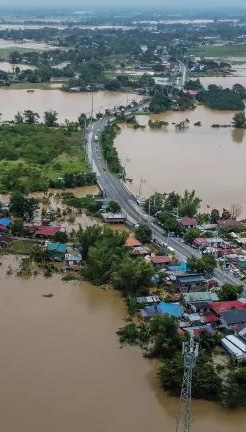More than 100 people remain missing in northern Pakistan after flash floods have killed at least 360 across the country
 By SHAHZAD RASHEED
By SHAHZAD RASHEED
Climate change refers to long-term shifts in temperatures and weather patterns. Such shifts can be natural, due to changes in the sun’s activity or large volcanic eruptions. But since the 1800s, human activities have been the main driver of climate change, primarily due to the burning of fossil fuels like coal, oil and gas. Burning fossil fuels generates greenhouse gas emissions that act like a blanket wrapped around the Earth, trapping the sun’s heat and raising temperatures. The main greenhouse gases that are causing climate change include carbon dioxide and methane. These come from using gasoline for driving a car or coal for heating a building, for example. Clearing land and cutting down forests can also release carbon dioxide. Agriculture, oil and gas operations are major sources of methane emissions. Energy, industry, transport, buildings, agriculture and land use are among the main sectors causing greenhouse gases. Pakistan has been dealing with the terrible effects of natural disasters for a long time. In recent Years, they have become much more common and severe. This growing trend is a major threat to the Health and well-being of the people in the country and its economic growth. The Indus River basin in particular has been devastated by the repeated monsoon floods that have hit different regions of the nation. More than 100 people remain missing in northern Pakistan after flash floods have killed at least 360 across the country and Pakistan-administered Kashmir since Friday. Most of the victims have been in the mountainous Khyber Pakhtunkhwa province in the northwest, where entire villages have been swept away as swollen rivers, mudslides and collapsing homes left families buried beneath debris. Officials said, Buner was hit by a cloudburst, a rare phenomenon in which more than 100mm (4 inches) of rain falls within an hour in a small area. In Buner, there was more than 150mm (6 inches) of rain within an hour on Friday morning. Cloudbursts typically occur in mountainous regions during the monsoon season when weather conditions can produce sudden, localized downpours leading to landslides. Cloudbursts tend to occur over a small area of 20 to 30sq km (7.7 to 11.6sq miles) and are often accompanied by thunder, lightning and sometimes hail. In Pakistan, the monsoon season typically runs from July to September with peak rainfall usually occurring in August. Since late June, torrential monsoon rains have battered Pakistan, triggering landslides and flash floods that have killed more than 650 people and injured nearly 1,000, according to officials. According to a PDMA report earlier today, Shangla reported 37 deaths, Mansehra 23, Swat 22, Bajaur 21, Battagram 15, Lower Dir five and a child drowned in Abbottabad. Detailing infrastructure damage, the report said 11 houses were destroyed while 63 were partially damaged due to the floods. Two schools in Swat and another in Shangla were also affected. In Buner, district in Khyber Pakhtunkhwa, at least 207 people have been killed over two days as floods and landslides swept through villages and destroyed homes. The district is predominantly hilly with steep slopes that feed into narrow valleys. The district’s loose, erosion-prone soil coupled with deforestation makes it vulnerable to landslides and flash floods. Monsoon floods are once again devastating communities across Pakistan, recalling the 2022 disaster that submerged one-third of the country. Beyond the immediate crisis, there is an urgent need to safeguard lives and livelihoods. By investing in water-smart infrastructure and data-driven planning, Pakistan can reduce the human toll and turn seasonal risk into resilience. Pakistan is navigating through the worst climate crisis and it will only worsen if we do not act now. Increased and intense heat waves, devastating floods, and depleting freshwater resources, all call for improving Pakistan’s resilience to climate change impacts. It is time to reinvent our development models and address these challenges which pose serious threats to local communities, critical ecosystems and economies. Forests are one of the best examples of nature-based solutions. Home to 80% of the world’s terrestrial biodiversity, forests provide clean air and water, protect against erosion and landslides, and help to regulate the climate by removing carbon from the atmosphere. The most viable long-term solution is to prevent the exacerbation of climate-related disasters in the first place. This can only be achieved by strengthening communities’ resilience to climate change while expanding efforts to reduce carbon dioxide from the atmosphere. Although technological solutions such as carbon capture and storage or developing carbon credit frameworks may be ideal for reducing greenhouse gas emissions, these initiatives demand significant financial investment and a strong regulatory framework—both of which are limited in Pakistan. That is not to say Pakistan cannot build on it; however, considering the present economic and political landscape, the need of the hour is cost-effective, ecologically friendly, and people-empowering solutions to help communities fight extreme climate events.

